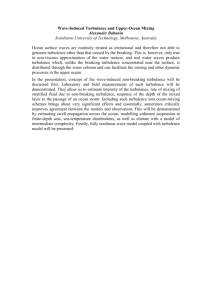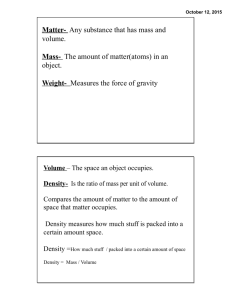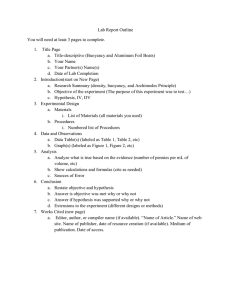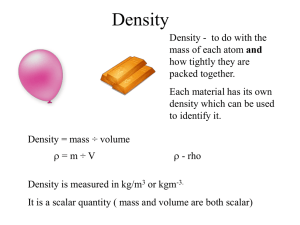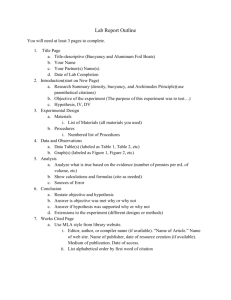RENORMALIZATION GROUP ANALYSIS THERMAL TURBULENCE May FOR
advertisement
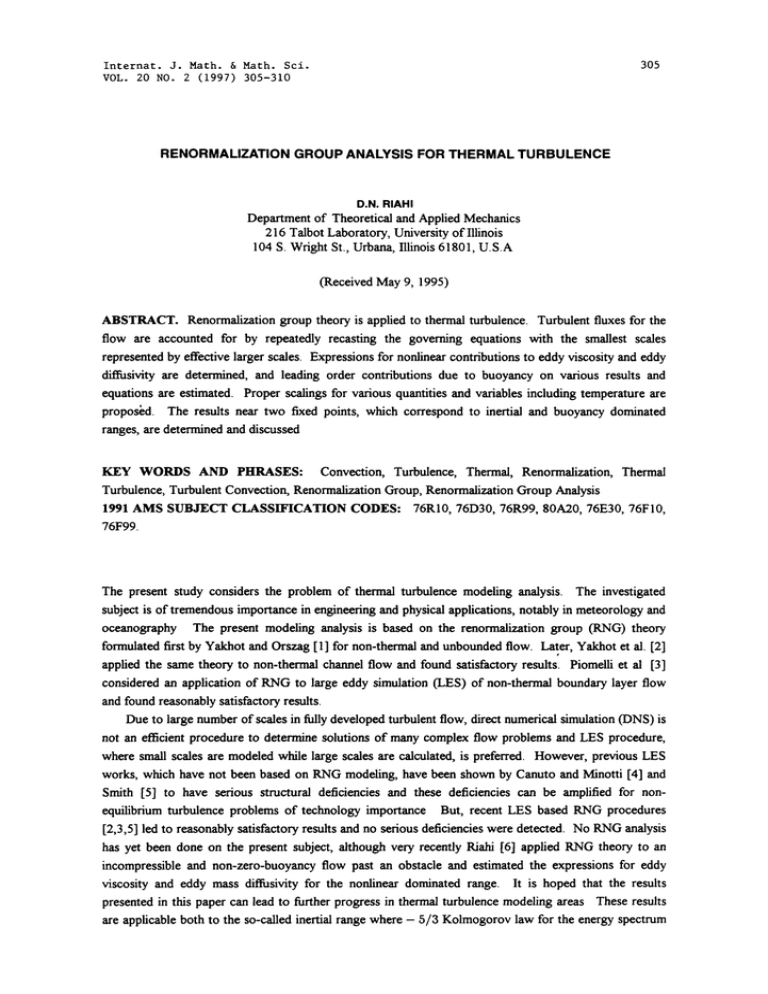
305
Internat. J. Math. & Math. Sci.
VOL. 20 NO. 2 (1997) 305-310
RENORMALIZATION GROUP ANALYSIS FOR THERMAL TURBULENCE
D.N. RIAHI
Department of Theoretical and Applied Mechanics
216 Talbot Laboratory, University of Illinois
104 S. Wright St., Urbana, Illinois 61801, U.S.A
(Received May 9, 1995)
ABSTRACT. Renormalization group theory is applied to thermal turbulence. Turbulent fluxes for the
flow are accounted for by repeatedly recasting the governing equations with the smallest scales
represented by effective larger scales. Expressions for nonlinear contributions to eddy viscosity and eddy
diffusivity are determined, and leading order contributions due to buoyancy on various results and
equations are estimated. Proper scalings for various quantities and variables including temperature are
proposbd. The results near two fixed points, which correspond to inertial and buoyancy dominated
ranges, are determined and discussed
KEY WORDS AND PHRASES:
Convection, Turbulence, Thermal, Renormalization, Thermal
Turbulence, Turbulent Convection, Renormalization Group, Renormalization Group Analysis
1991 AMS SUBJECT CLASSIFICATION CODES: 76R10, 76D30, 76R99, 80A20, 76E30, 76F10,
76F99.
The present study considers the problem of thermal turbulence modeling analysis. The investigated
subject is of tremendous importance in engineering and physical applications, notably in meteorology and
oceanography The present modeling analysis is based on the renormalization group (RNG) theory
for non-thermal and unbounded flow. Later, Yakhot et al. [2]
formulated first by Yakhot and Orszag
applied the same theory to non-thermal channel flow and found satisfactory results. Piomelli et al [3]
considered an application of RNG to large eddy simulation (LES) of non-thermal boundary layer flow
and found reasonably satisfactory results.
Due to large number of scales in fully developed turbulent flow, direct numerical simulation (DNS) is
not an efficient procedure to determine solutions of many complex flow problems and LES procedure,
where small scales are modeled while large scales are calculated, is preferred. However, previous LES
works, which have not been based on RNG modeling, have been shown by Canuto and Minotti [4] and
Smith [5] to have serious structural deficiencies and these deficiencies can be amplified for nonequilibrium turbulence problems of technology importance But, recent LES based RaNG procedures
[2,3,5] led to reasonably satisfactory results and no serious deficiencies were detected. No RNG analysis
has yet been done on the present subject, although very recently Riahi [6] applied RaNG theory to an
incompressible and non-zero-buoyancy flow past an obstacle and estimated the expressions for eddy
viscosity and eddy mass diffusivity for the nonlinear dominated range. It is hoped that the results
presented in this paper can lead to further progress in thermal turbulence modeling areas These results
are applicable both to the so-called inertial range where- 5/3 Kolmogorov law for the energy spectrum
306
D N RIAHI
is still applicable in the presence of buoyancy [7,8] and to the so-called buoyancy range where
3 law
for the energy spectrum holds [8]
We consider the thermal turbulent flow which is governed by the continuity, momentum and heat
equations which are coupled through the buoyancy force term in the momentum equation Boussinesq
approximation together with a linear dependence of density on the temperature T are assumed [7] so that
the governing equations can be written in the following form
Ot
+u_-Vu_
Po
Vp+ v0V2u_ + gT313o,
V-u_ =0,
OT
0t
(la)
(lb)
+ u.-VT aoV2T.
(lc)
Here _u is the velocity vector, p is the pressure, is the time variable, P0 is a reference (constant) density,
vo is the kinetic viscosity, #v is the coefficient of thermal expansion, g is the acceleration due to gravity
and a0 is the thermal diffusivity coefficient Such system of equations can be applied to both open flow
systems (such as wake flows) and close flow systems (such as Rayleigh-Benard convection) Following
Yakhot and Orszag [1 and their correspondence principle, we add a Gaussian random force f to the
momentum equation (l a) so that the resulting system becomes statistically equivalent to the original
system (1) at least in the inertial range [8]. We then define the Fourier decomposition of _u, T and p fields
in the range k < A,where k is the magnitude of the wave number vector .k and A is an ultraviolet cutoff
The space-time Fourier-transformed system of governing equations is a system of equations for the
transformed quantities f_-(), ’(), () and () for _f, .u, T and p, respectively, where
(.k, w) and
w is the frequency. Next, we assume that the modes vanish for k larger than the ultraviolet cutoff and
write
(f,,,P) (.<
u<
T< p<) + (f> u > T > p>)
(2)
where the quantities with the superscript < (long-wavelength modes) belong to the interval 0 < k < A
exp( r), while the quantities with the superscript > (short-wavelength modes) belong to the interval A
exp( r) < k < A. Here r is a positive constant. The expression (2) is used in the governing system for
the transformed quantities and two formal paramgters A( 1) and 6o( 1) are introduced in front of
the nonlinear terms in the momentum and heat equations, respectively, to facilitate the perturbation
solution ofthe system.
The RNG procedure consists of two steps. First, all short-wavdength modes terms in the system are
removed, up to order A6 (n + m 3) and third order or higher of these terms, by repeated
substitution of the system for the short-wavelength modes into the system for the long-wave length
modes. Second, averages are taken over the pan f> of the random force f. The following resulting
system of equations for ,< and T<, which contains only long-wavelength modes terms up to and
including order A6 ( + m _< 2), is an approximation which is valid in the limit of small
iw + v(r)k2]u?(;)
[- iw + a(r)k2]T<()
AO
<... <
(; )a/(2r) k+l
f?(;) i-p,(k)#
[ u.(q)u.
+ [/30P3z(.k)g-/(r)k2]T<(),
f T< ()u/(
)d/(2r) d/l + am(k_, r)u<(),
,
(3)
(4)
where kl, Ul and fl denote l-th components of .k, u. and f, respectively, is the pure imaginary number,
d is the dimension of space, and the expressions for v, a,
am, P3 and Pm, are given in the
appendix. The coefficients #1 and a. are introduced in (3)-(4) are both due to presence of the buoyancy
RENORMALIZATION GROUP ANALYSIS FOR THERMAL TURBULENCE
307
term in the momentum equation, and it is constructive to discuss briefly here the origins of the two terms
in (3)-(4) which contain these two coefficients The term/31T < in (3), which is found to be of order
A060, is obtained by first considering the equation for u_ < which contains an integral of u_<u. > Then the
equation for u.>, which contains a buoyancy term for T >, is used to eliminate _u leading to an integral
containing T > in the equation for _u<. Next, the equation for T>, resulted from the heat equation, is used
to eliminate T>, and lowest order term in the equation for u is applied leading to the term/31T < The
term ,u in (4), which is found to be the sum of two terms of orders Ao60 and 6o2, is obtained by first
considering the heat equation for T which contains an integral of T<_u > Then, the equation for u. >,
which contains a buoyancy term for T and an integral of u_<u_>, is used to eliminate u_ Next, the lowest
order terms in the equation for u_ plus the heat equation for T are used which lead to the term ,u,
From the results (A1)-(A2) given in the appendix, it is seen that the nonlinear contribution v v0 to
eddy viscosity does not depend on the Prandtl number P0 vo/ao, while the nonlinear contribution
a a0 to eddy diffusivity does depend on P0. As can be seen from (3)-(4), some contributions to eddy
viscosity and eddy diffusivity come through nonlinear inertial and nonlinear thermal convection terms,
while the rest of the contribution come through buoyancy term. The former contribution is essentially the
same as in the case of turbulence in the absence of buoyancy [1] and lead to the well known
5/3 laws
for both energy and temperature variance spectrums in the inertial range [1 ]. Our analysis and results
presented above and later will explain why the well known-5/3 laws still hold for thermal turbulence in
the inertial range [4,7,8] (larger k limit range).
Next, following Yaldaot and Orszag [1], we rescale the variables and the parameters. Presence of
buoyancy and term due to buoyancy in (2)-(3) dictate that rescaling should be according to
k
k’ exp( r), (w, cr.)
(v’, a’, )exp[(2 a)r],
(v, a,/3t)
(_u <, T<)
(w’, ) exp(
(_u’< T’<) exp[(3a + d + y)r/2]
(5)
f’ exp[(a + d + V)r/2],
f
where a is a parameter and k’ is defined on the same interval 0 < k’ < A as the wavenumber in the
original system of equations. Using these rescaling, dropping primes for simplicity of notation and
following the same procedure as the one due to ref. for larger k limit range, w,e find the following
results:
dv
(6a)
via- 2 + AdA2],
dr
da
dr
a[a- 2 + Ba62],
(6b)
where these equations are formulated by consideration of asymptotic limit r --, 0 for the larger k limit
range ], and the dimensionless expansion parameters A and 6, introduced in (6a, b), are satisfied by the
following equations
2d
A(- 3AdAg-),
(7a)
2d__ 6( 3Bd2),
dr
(Tb)
dr
where
and 6
4 + $/- d and the expressions for Ad and Bd are given in the appendix. For < 0, )
oo, where
oo. However for > 0, (A, 6) approaches a fixed point (A*, 6*) as r
0 as r
(a’,’)
A/,-/
0
8)
308
D N. RIAHI
At this fixed point, both a and v become independent of r if
a-- 2-
/3.
(9)
Now, in the inertial range (larger k limit range), where the minus five-thirds laws hold for the energy,
heat flux and temperature variance spectrums [8], we apply the expressions for these spectrums [8] and
find that they hold for e
4 fixed point.
for the
4 and a
2/3. Using our above results, it is then seen that (v, a)
k -4/3
Before considering the smaller k limit range case, it is useful to modify (3)-(4) to a form where
nonlinear and buoyancy contribution to eddy viscosity and eddy diffusivity can be evaluated We find
from (3) and use it in (4) and find T < from (4) and use it in (3). This procedure leads to a modified form
of (3)-(4), where the .u term in the left hand side of (3), in the limit of w 0, becomes
,()[ () + ( [() &P(.)]o (_, )/[()]),%(),
and the T< term in the left hand side of (4), in the limit of w
(0a)
0, becomes
() + [() &p(_)]o(., )/[()-])T< (t).
(0b)
It is of interest to note from (10) and (AS)-(A6) in the appendix that for larger k limit range case where
r
0, buoyancy contributions to (10) are much smaller than the nonlinear contributions to (10) These
results provide further supports to our analysis and results for the inertial range presented above
Another observation for (3)-(4) and (10) is that, although the nonlinear contributions to eddy quantifies
does not depend to any particular component of u, the buoyancy contributions to eddy quantities does
depend, in general, to different components of _u and provide the effects due to the three components of u_
along any of the coordinate axis.
We now consider the smaller k limit range case. Using the rescaling (5) and formulating in the limit
of k 0, we find that only part of the buoyancy contributions to (10a) and (l 0b) designated here by
and
), respectively, which contain s,p, dominate over the rest of the terms in (10). Investigating
either
or ), we find that either ofthese quantities satisfy the equation
S
S
S S
dr
-(-6+a)S,),
and, thus, S, becomes independent of r as r
as r---,oo,
(i=1,2),
(11)
oo, provided that
a
(12)
6- e.
In analogy to the expansion parameters A and 6 and the corresponding equations (Ta, b) in the larger
k limit range case, new parameters A and 5, in the smaller k limit range case, are defined, which satisfy
equations of the form
d
r(Xl,l)--" (6--)(Xl,I),
r ---, oo.
(13)
It is seen from (:3) that A and become independent of r for e 6 as r --, oo. Using e 6 in (12),
we find a 0. It is of interest to note that minus three law (k -3), that is known to be valid for the
energy spectrum in the buoyancy range (smaller k limit range) [8], is followed here for e 6 and a 0
As can be seen from (5), u < T< so that k-31aw follows also for the temperature flux spectrum and for
the temperature variance spectrum [8] in the smaller k limit range. Using the above results for the e 6
fixed point and (5), it is then seen that (S),
)) k -2 for the e 6 fixed point Hence eddy viscosity
and eddy diffusivity at the e 6 fixed point dominate those at the e 4 fixed point, determined earlier,
S
oo limit. This result is consistem with the way
0 limit, while the opposite is true for the k
inertial and buoyancy ranges are defined [8].
The resuks presented above for both e 4 fixed point (larger k’ limit range) and e 6 fixed point
(smaller k limit range) are in agreement with the physical modelling based on the hypothesis put forward
for k
RENORMALIZATION GROUP ANALYSIS FOR THE TURBULENCE
309
by Shur [9] and Lumley [10] about the turbulence spectrum in a free atmosphere according to which the
region of the validity of the k -5/3 law is followed by a region of smaller wave numbers where the k -3
law holds
Recently Sukoriansky et al [11] applied the KNG method to study the two dimensionalization of
three-dimensional non-thermal turbulence as a result of influence of a strong magnetic field They
determined a fixed point corresponding to e 6, where the k -3 law was followed by the energy
spectrum, and their results were in good agreement with the experimental data due to Sukoriansky and
Branover 12] The results of the present investigation, which indicate the preference of the e 6 fixed
point and the existence of the k law in the buoyancy range of the strong buoyancy dominated
turbulence where two-dimensionalization of the flow in the horizontal direction is enhanced, are in
agreement with those due to Sukoriansky et al. 11 of their magnetohydrodynamic turbulence studies
An interesting result of the present study was found to be in the buoyancy range
3) law, which is
known to be valid in the stably stratified turbulence in the smaller k limit range, is followed by the energy
spectrum E (k) of thermal turbulence, while E (k) follows
5/3) law in the inertia range for the larger
k limit range Further support for this result, in addition to those discussed earlier [10,11], can be
obtained from very recent DNS studies of turbulent Rayleigh-Benard convection by Kerr [13], which
indicate that the mean temperature gradient S of the flow is slightly positive in the region away from the
walls, while S is negative near the wall regions. Hence, we may propose the opinion that in thermal
turbulence smaller scale eddies in the inertia range favor three-dimensional unstably stratified
environment, while larger scale eddies in the buoyancy range favor quasi two-dimensional stably stratified
-
environment.
APPENDIX
P3I (.) and Plm,(.), introduced in (3)-(4), are given below
vo + )DoSd(d d )[exp(r) 1]/[2vA(2r)d(d + 2)],
The expressions for v(r), a(r),
v(r)
c(r)
Co
+ 6Do(d- 1)Sd[exp(er) 1]/[edvo(uo + C,o)2)2A’],
Pa(_k)
63 k3k/k
(AI)
(A2)
(A3)
(A4)
where Do TovoKB/Po, To is a reference temperature of the fluids, P0 is a reference fluid density, KB is
-2 describes fluid in thermal
Boltzmann’s constant, e 4 + y-d, y > -2 is a constant (y
equilibrium, y > 2 corresponds to strongly nonequilibfium flow cases [1]), Sd 27/2/F(d/2)is the
and
area of d-dimensional unit sphere
6,n
1 form=n,
0 otherwise.
The expressions for ,61 (r) and a, (k, r), introduced in (3)-(4) are given below:
2ft(r
Ao6oDofog(d2
2)Sd[exp(’r)- 116ra/[2Vo2(,o + to)d(d + 2)’A’(2r)’]
’= e+2,
(A5)
(A6)
o
D N RIAHI
,
ns
where the coefficients
and as’n, are two constants independent of r and whose numerical values
cannot, in general, be determined analytically, and they are given by the following surface integrals
,s
as,n,
[p3n(q_)pk(q_)/p.3(q_)]sinOdO(qk/q)
de
de
0
2r
{[q,Ps(q.) + q,Pm(q_)]P,t(q.)/[P3t(q.)qp]} sinOdO.
Here two repeated subscripts me summation om to 3 d
,
ql/q
(A7)
sin cos 0, q/q
sin sin 0, q3/q
cos
(AS)
.
d
NumeficM vMues of
c, of course, be detened numeficMly from numeficM inteations
in (A7)-(AS) but 11 not be need here. The expressions for Aa d
of the inteals
bdow
imrodud in (6)-(7), e
ven
ven
Ad
Bd
Sa(d
d
,)/[2d(d + 2)(2)a],
Sd(d- 1)/[d(1 + Po)Po(2rr)d].
(A9)
(AIO)
REFERENCES
YAKHOT, V. and ORSZAG, S.A., Renormalization group analysis of turbulence, J. of Scientific
Computing, 1 (1986), 3-51.
[2] YAKHOT, A., ORSZAG, S.A., YAKHOT, V. and ISRAELI, M., Renormalization group
formulation of large-eddy simulation, d. of Scientific Computing, 4 (1989), 13 9-158
[3] PIOMELLI, U, ZANG, T.A., SPEZIALE, C.G. and LUND, T.S., Application of renormalization
group theory to the large-eddy simulation of transitional boundary layers, Instabdity and
Transition, Edited M.Y. Hussaini and R.G. Voigt (Springer-Verlag), II (1990), 480-496
[4] CANLrrO, V.M and MINOTTI, F., Stratified turbulence in the atmosphere and oceans a new
subgrid model, J ofAtmospheric Sciences, 50 (1993), 1925-1935.
[5] SMITH, L.M., An adaptation and extension of the Crow constraint for the k-e equations, Proc. of
Office of Naval Research Workshop on Non-equilibrium Turbulence (March 1993, Tempe, AZ)
(1993), 6-9.
[6] KIAHI, D.N., Renormalization group theory modeling for a stratified turbulence, Proc. oflnstitute
for Computer Applications in Science and Engineering and lzmgley Research Center Workshop on
Transition, Turbulence and Combustmn (June-July 1993, Hampton, VA), H (1994), 133-136.
[7] MONIN, A.S. and YAGLOM, A.M., Statistical Fluid Mechtmics: Mechanics of Turbulence, 1,
MIT Press (Cambridge, MA), 1971.
[8] MONIN, A.S. and YAGLOM, A.M., Statistical Fluid Mechanics: Mechamcs of Turbulence, 2,
MIT Press (Cambridge, MA), 1975
[9] SHUR, G.N., Experimental investigation of the energy spectrum of atmospheric turbulence, Trudy
ofAerological Observation, 43 (1962), 79-90.
[10] LUMLEY, J.L., The spectrum nearly inertial turbulence in a stably stratified fluid, J. of
Atmospheric Sciences, 21 (1964), 99-102.
[11] SUKOKIANSKY, S., STROSELSKY, I., GALPERIN, B, ROY, S.A and ORSZAG, S A.,
Renormalization group analysis of MHD turbulence with low magnetic Reynolds numbers,
Progress m Astronautics and Aeronautics, 116 (1992), 151-158.
[12] SUKOtLIANSKY, S. and BKANOVER, H., Turbulence peculiarities caused by interference of
magnetic fields with the energy transfer henomena, Progress in Astronautics and Aeronauttcs, 112
(1988), 87-99.
13 KERR, R.M., Rayleigh number scaling in numerical convection, to appear in J. of Fluid Mechamcs
(1995).


